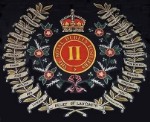"Nighttown" in Trieste
While Joyce's Dublin had one notorious redlight district, "The Monto," the brothels of Trieste were in two areas: Cittavecchia, where the original walled city stood, and Cavana, a dockside district. Within these two districts, the area with the greatest density of brothels was the Old Ghetto.
n/ Erik Holmes Schneider, Zois in Nighttown, (London: Ashgrove, 2014).
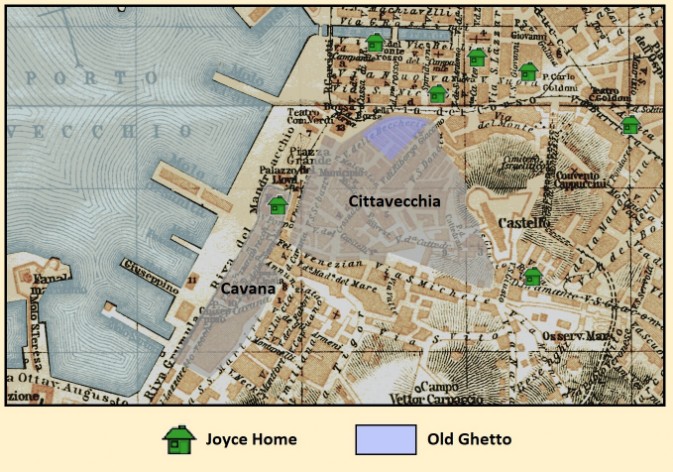
Plan of Trieste, Baedeker's Guide for Austria-Hungary, 1911
Il Ghetto Ebraico di Trieste was established by the municipal authorities in 1684. The city's 70 to 80 Jewish residents were required to live in this walled area within the walled city and could not venture outside the ghetto's confines during hours of darkness. In 1746, the Triestine Jews opened their first synagogue (Scuola Piccola) near the ghetto gate on Via delle Beccherie. Civil disabilities of Austria's Triestine Jewish subjects were partially lifted by Empress Maria Theresa in 1771. For example, pursuant to new regulations, wealthy Jews could obtain licenses to live outside the ghetto. The Trieste Ghetto was abolished in 1782 by Emperor Joseph II's Edict of Toleration. At the time, about 1,000 Jews lived in Trieste, 6% of the city's population. They were the largest minority in the city and "playing an active and prominent role in the city's commerce."
n/ Lois C. Dubin, "A Tale of Two Cities: How Trieste-Vienna Alters Our Perspective on Eighteenth-Century Jewish History," Proceedings of the World Congress of Jewish Studies (1997): 147-53.
The Old Ghetto as Seen by Joyce
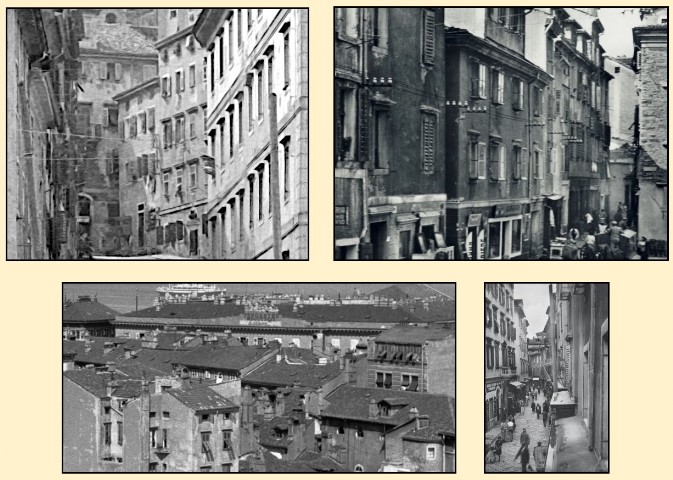
Many of Cittavecchia's old buildings, and even streets, vanished during the 1930s urban renewal of this oldest part of the city. Most of the Old Ghetto structures were demolished, including the Scuola Piccola.
During Joyce's years in Trieste, the Ghetto Ebraico was no longer inhabited exclusively by Jews, and there, they were probably a minority. By 1907, most of the Triestine Jews lived outside the Old City as the site they chose for the new Tempio Israelitico di Trieste (built 1908-12) was near the Public Gardens, one kilometer northeast of the ghetto. The new synagogue replaced the existing three Jewish houses of worship: Scuola Piccola, Scuola Grande (built in the Old Ghetto in 1798 and housing two congregations, one Sephardic), and Scuola Vivante (built 1828 just outside of Cittavecchia at Via del Monte 3). Note that the first synagogues in Trieste were named "school" as the buildings all contained schools attended by the city's Jewish children.
n/ Zeno Saracino, "The Lost Synagogue of Trieste," Redazione Trieste All News, April 2, 2020, www.triesteallnews.it. Click on the link and the article from the news website will appear in a new browser window.
Surviving Segment of Via delle Beccherie
One of the Ghetto's Main Thoroughfares
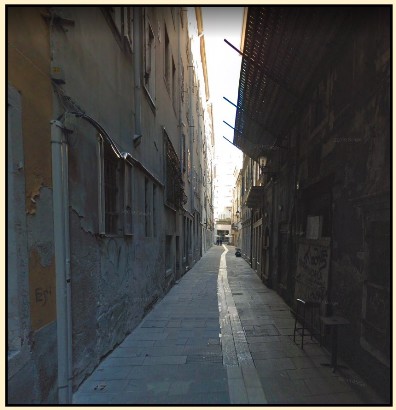
© 2020 Google
Brothels and Prostitution in Trieste
All of Trieste's bordellos were in two working class neighborhoods, Cittavecchia (the old city) and Cavana. Near the brothels were numerous dive bars and inexpensive eateries that catered to the sex trade customers. While prostitution was a feature of these two districts, that trade and its ancillary businesses was not the primary employer of the residents. Most inhabitants of Cittavecchia and Cavana were dependent financially on the maritime trade, with the man of the household either a mercantile sailor, stevedore, or dockside warehouseman.
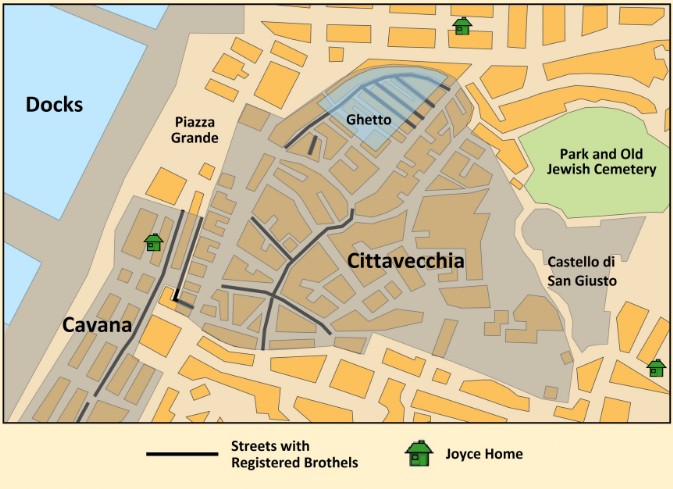
Source: Schneider, Zois in Nighttown .
Austrian statutes gave municipalities complete discretion as to the control of prostitution. Cities effectively legalized the trade but imposed many regulations, especially with regard to spread of venereal disease. At the turn of the twentieth century, prostitution was rampant in most cities of the Austro-Hungarian Empire and the red-light districts of Vienna, Prague, and Trieste were notorious throughout Europe.
"Commercial sex in Trieste was regulated through an ordinance passed in 1888 and amended in 1906. The city effectively legalized prostitution in brothels and made it difficult for women to engage lawfully in commercial sex outside of the casini (the Triestine term for brothel). Brothel-keepers and prostitutes had to register with the police and women registered as prostitutes had to undergo medical examination twice each week. Prostitutes diagnosed with a venereal disease were confined in the 7th Division of the Ospedale Maggiore until a physician found them to be cured. The ordinance had numerous provisions that limited public solicitation, such as a prohibition on prostitutes loitering near restaurants, theatres, and the better cafes and bars. Virtually none of these regulations to limit solicitation was observed. The newspapers of the period 1900-1915 are replete with letters and articles decrying the aggressive soliciting of prostitutes, their public drunkenness, scandalous behaviour and foul language, and the large nightly gatherings of prostitutes in public areas, especially in Piazza delle Scuole Israelitiche, which was adjacent to the two main Jewish synagogues in the Ghetto, and in Piazza Cavana."
"In addition to the 'house' prostitutes, there were private prostitutes, registered or not, with a health booklet or not, who lived singly or with one or two other women in many different areas of the city and who often had a more regular and select clientele, and the so-called clandestine prostitutes (the Victorian term was 'privateer'), who were generally at the lowest end of the scale. These women could be full-time or career prostitutes but were more often unemployed domestics or other members of the burgeoning female working class in Trieste who chose to prostitute themselves when unemployed or in financial straits due to lack of family or loss of support by a working male."
During Joyce's stay in Trieste there were about 300 registered casini prostitutes working in 40 to 45 houses and between 100 and 150 independent prostitutes. Note that Pola, with one-fourth the population of Trieste, had 415 known prostitutes at the time that Joyce lived there. This was because of the large naval presence and that city's proximity to an impoverished, rural hinterland. Hardly any of the Triestine prostitutes were native to the city as throughout the Austro-Hungarian Empire, such women rarely plied their trade in their home towns.
n/ Schneider, Zois in Nighttown.
Joyce and the Redlight Districts of Trieste
For nine months James Joyce and his family lived two blocks north of Cittavecchia (Via San Nicolo 30) and on his return to Trieste after the First World War, lived for nine months in Cavana (Via Della Sanita 2) opposite a registered brothel. Also, the Berlitz School, at which he taught intermittently from March 1905 through July 1908, was also on Via San Nicolo. James' younger brother Stanislaus for a while lived in Cittavecchia on the Via delle Beccherie and also taught at the Berlitz School.
As the Berlitz School was a short walk from the Old Ghetto, that area, with its high density of brothels, must have been one of the first discoveries made by Joyce when he began exploring Cittavecchia in 1905. Additionally, as Joyce attended worship services at the synagogues of Trieste (as well as at Catholic and Orthodox churches) he could not have avoided the prostitutes who congregated at the Piazza dell Scuole Israelitiche. The Scuola Grande was situated on that piazza and the Scuola Piccolo was nearby. In that the Nighttown of Trieste was much closer in time to the writing of Ulysses than its counterpart in Dublin, it's possible that the novel's "Circe" episode reflects more of Cittavecchia than of the Monto. Bella Cohen's brothel; however, would be modeled on a Monto establishment as we have no evidence that Joyce ever entered a casini during his years in Trieste.
According to Silvio Benco, an Italian novelist who in Trieste befriended Joyce, Ulysses' author loved to spend evenings chatting, smoking, and drinking in small taverns in Cittavechia. Joyce's favorite drink was white Chianti.
n/ Schneider, Zois in Nighttown; Silvio Benco, "James Joyce in Trieste" in Portraits of the Artist in Exile, Willard Potts, ed. (Seattle: Univ. of Washington Press, 1979).
Links to Other Websites
Note: The webpages will open in new windows.
Click on the link to go to that page of the website. Click on the icon to go to the website's home page.
Article by Jeff Campagna in the Daily Beast. Features an interview with Erik Schneider, Joyce scholar and founder of the Museo Joyce, Trieste. Click on the link for the museum's home page which will appear in a new browser window.
Illustrated article on the website of Yes Tour, an Italian travel and guided tour agency.
Short article by Andrea De Monte and Simone Zacchingna on the website Lo chiamavano Zois ... (they called him Zois) which contains material on Joyce in Trieste.
[ You are at www.majortweedy.com>Joyce's Trieste>Redlight Districts ]
